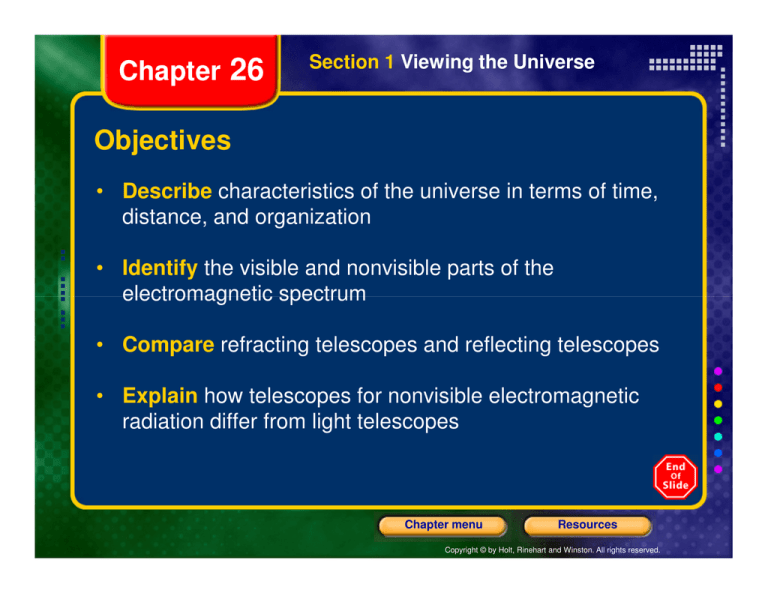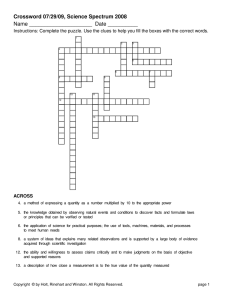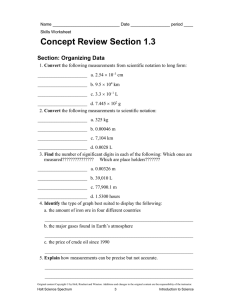
Chapter 26
Section 1 Viewing the Universe
Objectives
• Describe characteristics of the universe in terms of time,
distance, and organization
• Identify the visible and nonvisible parts of the
electromagnetic spectrum
• Compare refracting telescopes and reflecting telescopes
• Explain how telescopes for nonvisible electromagnetic
radiation differ from light telescopes
Chapter menu
Resources
Copyright © by Holt, Rinehart and Winston. All rights reserved.
Chapter 26
I. The Value of Astronomy
1. Astronomy the scientific study of the
universe
b. astronomers have discovered new planets,
stars, black holes, and nebulas.
Chapter menu
Resources
Copyright © by Holt, Rinehart and Winston. All rights reserved.
Chapter 26
c. studying these objects, they have learned
more about the origin of Earth and the
processes in the formation of our solar
system.
d. how stars shine may one day lead to
improved or new energy sources on Earth.
e. Astronomers may learn how to protect us
from potential catastrophes, such as
collisions between asteroids and Earth.
Chapter menu
Resources
Copyright © by Holt, Rinehart and Winston. All rights reserved.
Chapter 26
Section 1 Viewing the Universe
II. Characteristics of the Universe
A. Organization of the Universe
1. Galaxy: a collection of stars, dust, and gas bound
together by gravity
2. The solar system includes: sun, Earth, the other
planets, and many smaller objects (asteroids and
comets).
3. The galaxy in which the solar system resides is
called the Milky Way galaxy.
Chapter menu
Resources
Copyright © by Holt, Rinehart and Winston. All rights reserved.
Chapter 26
Section 1 Viewing the Universe
B. Measuring Distances in the Universe
1. astronomical unit: the average distance between the
Earth and the sun; approximately 150 million kilometers
(symbol, AU)
a. Astronomers also use the speed of light to measure
distance.
b. Light travels at 300,000,000 m/s. In one year, light
travels 9.4607 x 1012 km, known as a light-year.
c. Aside from the sun, the closet star to Earth is 4.2
light-years away.
Chapter menu
Resources
Copyright © by Holt, Rinehart and Winston. All rights reserved.
Chapter 26
Section 1 Viewing the Universe
III. Observing Space
A. Electromagnetic Spectrum
1. electromagnetic spectrum: all of the
frequencies or wavelengths of
electromagnetic radiation.
a. Examples: Light, radio waves, and X rays
Chapter menu
Resources
Copyright © by Holt, Rinehart and Winston. All rights reserved.
Chapter 26
Section 1 Viewing the Universe
B. Visible Electromagnetic Radiation
1. Though all light travels at the same speed;
different colors of light can be seen through a
spectrum.
2. Electromagnetic radiation (shorter or longer
than wavelengths of violet or red light) cannot be
seen by humans.
Chapter menu
Resources
Copyright © by Holt, Rinehart and Winston. All rights reserved.
Chapter 26
Section 1 Viewing the Universe
C. Invisible Electromagnetic Radiation
1. Invisible wavelengths: infrared waves,
microwaves, radio waves, ultraviolet rays, X
rays, and gamma rays, and detected only by
instruments.
2. In 1852, a scientist named Sir Frederick
William Herschel discovered infrared, which
means “below the red.”
Chapter menu
Resources
Copyright © by Holt, Rinehart and Winston. All rights reserved.
Chapter 26
Section 1 Viewing the Universe
IV. Telescopes
1. telescope: collects electromagnetic radiation
from the sky and concentrates it for better
observation.
2. Telescopes that collect only visible light are
called optical telescopes.
a. The two types: refracting and reflecting.
Chapter menu
Resources
Copyright © by Holt, Rinehart and Winston. All rights reserved.
Chapter 26
Section 1 Viewing the Universe
A. Refracting Telescopes
1. refracting telescope: uses a set of lenses to
bend and focus light from distant objects
B. Reflecting Telescopes
1. reflecting telescopes uses a curved mirror
to gather and focus light from distant objects
Chapter menu
Resources
Copyright © by Holt, Rinehart and Winston. All rights reserved.
Chapter 26
Section 1 Viewing the Universe
Telescopes, continued
The diagram below shows reflecting and refracting telescopes.
Chapter menu
Resources
Copyright © by Holt, Rinehart and Winston. All rights reserved.
Chapter 26
Section 1 Viewing the Universe
C. Telescopes for Invisible
Electromagnetic Radiation
1. Scientists have developed telescopes that
detect invisible radiation, such as a
radiotelescope for radio waves.
Chapter menu
Resources
Copyright © by Holt, Rinehart and Winston. All rights reserved.
Chapter 26
Section 1 Viewing the Universe
V. Space-Based Astronomy
1. In space, Earth’s atmosphere cannot
interfere with the detection of electromagnetic
radiation.
Chapter menu
Resources
Copyright © by Holt, Rinehart and Winston. All rights reserved.
Chapter 26
Section 1 Viewing the Universe
A. Space Telescopes
1. Hubble Space Telescope collects electromagnetic
radiation.
2. Chandra X-ray Observatory makes clear images
using X rays.
3. Compton Gamma Ray Observatory detects gamma
rays from black holes.
4. James Webb Space Telescope will detect infrared
radiation after it is launched in 2011.
Chapter menu
Resources
Copyright © by Holt, Rinehart and Winston. All rights reserved.
Chapter 26
Section 1 Viewing the Universe
B. Other Spacecraft
1. The Voyager 1 and Voyager 2 spacecraft
investigated Jupiter, Saturn, Uranus, and
Neptune.
2. The Galileo spacecraft orbited Jupiter and its
moons.
3. The Cassini-Huygens spacecraft will study
Saturn’s largest moon, Titan.
Chapter menu
Resources
Copyright © by Holt, Rinehart and Winston. All rights reserved.
Chapter 26
Section 1 Viewing the Universe
C. Human Space Exploration
1. Humans went into space in the 1960’s.
Between 1969 and 1972, NASA landed 12
people on the moon.
2. The loss of the Challenger in 1986 and the
Columbia in 2003, have focused public
attention on the risks of human space
exploration.
Chapter menu
Resources
Copyright © by Holt, Rinehart and Winston. All rights reserved.
Chapter 26
Section 1 Viewing the Universe
D. Spinoffs of the Space Program
1. Satellites provide information about weather.
2. Others broadcast television signals from or
allow people to navigate cars and airplanes
(GPS).
3. Medical equipment, like the heart pump,
improved based on NASA’s research on the
flow of fluids.
Chapter menu
Resources
Copyright © by Holt, Rinehart and Winston. All rights reserved.





